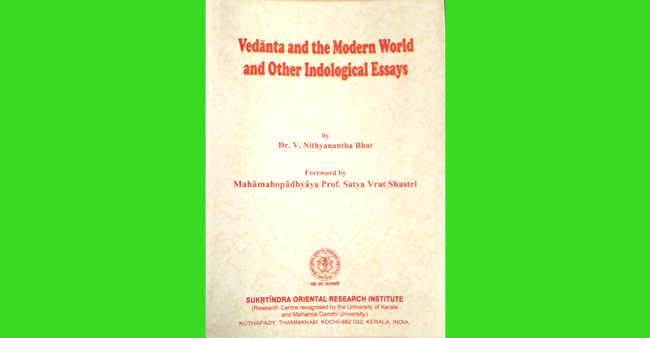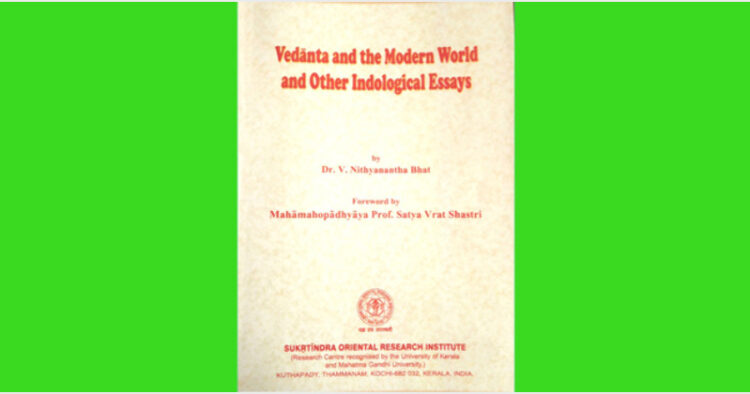Dr V Nithyanantha Bhat, honorary Director of Sukrtindra Oriental Research, has cogently explained how Vedanta suggests ways to enrich humans and unify the whole world. He has also expounded the Bharatiya view of globalisation in a comprehensive manner
–U Gopal Maller

Vedanta and the Modern World and other Indological Essays, Sukrtindra Oriental Research Institute Kuthapady, Thammanam, Kochi (Kerala ) Rs 200
Dr V Nithyanantha Bhat, honorary Director of Sukrtindra Oriental Research Institute, Kochi, is a prolific writer and an authority on Vedanta and Indology. He has written a number of articles on these subjects. “Vedanta and the Modern World and other Indological Essays,” in book form, is a compilation of 12 articles written by him and published in different reputed journals. The first four articles are based on Vedas and Vedanta, and three other articles are on education. The other five articles are on subjects like Indian Manuscript Tradition, Human Excellence, The Ideal of Renunciation, Service and Spirituality, True Globalisation: An Indian Perspective, and Nature of Poetry in Indian Perspective as Expounded by Sri Aurobindo.
The foreword written by renowned and erudite Sanskrit scholar, and recipient of the Jnanpith Award, Padma Bhushan, and President’s Certificate of Honour, Mahamahopadyaya Prof Satya Vrat Shastri ji, President, Asia Institute Torino, Italy, really adds to the grandeur of the book.
The fundamental texts of Vedanta philosophy are the Brahma Sutras, The Upanishads and the Srimad Bhagavad Gita, known as the Prasthana Traya. And the speciality of Vedanta philosophy is that it is not only not sectarian but universal and relevant for all times. And in his first article, Vedanta and Modern World, the author convincingly shows how Vedanta, apart from suggesting ways and means of enriching every sphere of individual and social life of humans, can unify the whole world and ennoble human life. The reason for it is simple: truth is One and universal. It cannot be limited to any country, race or individual.
“Gravity explains the motions of the planets, but it cannot explain who sets the planets in motion,” says physicist Sir Isaac Newton.
The exponential scientific progress we could make in the last few centuries, has not only helped us to better our living conditions on this planet, but also has brought about many grave deleterious consequences. The environmental concerns are the first and foremost among them! Presently, we are faced with a whole series of global problems which are harming the biosphere and human life in alarming ways. It is in this context, the article, Ecological Awareness in the Vedas, assumes significance, in which the author candidly deals with the subject as to how our Vedic forefathers were aware of the importance of our ecosystem and provided for its protection.
During the Vedic age, education in Bharat was residential. Stay in the residence of the teacher (Guru) provided the pupils with greater opportunity to thoroughly learn both science and art subjects. The celibate students, who used to lead a life of chastity and austerity, also used to imbibe practical lessons in ethics, morality and spirituality from the exemplary lives of their preceptors. In the article, Education in the Vedic Age, the author is shedding light on the educational system prevalent during the Vedic period, as well as its efficacy.
History records that the library at the Nalanda University, ransacked and burnt down by Mamluks, under Bakhtiar Khilji in 1193 CE, had a collection of 9 million books and manuscripts, which continued to burn for three months after the library was set on fire. According to an estimate, we are currently in possession of only ten per cent of our total wealth of manuscripts! In the article, Indian Manuscript Tradition, the author is tracing the history of transmission and dissemination of knowledge from one generation to another, first through the oral tradition, and then written tradition. It is important to note that the oral tradition still continues. In the chapter, True Education, the author discuses the thoughts of Swami Vivekananda, Sri Aurobindo, Mahatma Gandhi ji, Rabindranath Tagore, Dr S Radhakrishnan, Confucius, Albert Einstein, T S Eliot, etc., on education.
Likewise, in the chapter, The Teacher, the author makes the reader acquainted with an ideal teacher through the eyes of great savants and spiritual personalities like Swami Vivekananda, Sri Aurobindo and Dr S Radhakrishnan.
The chapter, Human Excellence, deals with what right from Greek philosophers Socrates and Plato, to modern Indian thinkers and spiritual luminaries have talked about human excellence. This is very much relevant now, where we find mediocrity ruling the roost!
“Immortality cannot be achieved through action, progeny or wealth. Sacrifice is the means to achieve it,” exhorts the Kaivalya Upanishad (verse 3). And through the article, The Ideal of Renunciation, the author, quoting the scriptures and teachings of great men like Sri Ramakrishna, Ramana Maharshi, etc., clearly and unequivocally establishes that shedding the feeling of ‘I’ forms the essence of renunciation. What is the relationship between service and spirituality? To find a satisfactory answer to this question, we have to first find an answer to the question “How did the creation happen?” The Upanishad answers this question with the following words: “Ekoham bahu syam.” That is, the Brahman thought, “I am One, let Me become many.” The very first verse of the Isavasyopanishad says: “God permeates the entire creation.” So, everything in the universe is nothing else but God in another form. It is in this context, service to Nara, becomes Narayana seva. In other words, service to humanity, is service to God. So, to have spiritual bent of mind and identification with the served or the beneficiary is a prerequisite for doing real service, which has been beautifully delineated by the author in the chapter, Service and Spirituality.
Globalisation was originally conceived by the Western world in the second half of the last century, to protect and enhance their economic interests and hegemony. And presently, we are witnessing the strange spectacle of the people of the same countries that once vociferously and enthusiastically promoted globalisation, bitterly regretting and protesting against it. However, globalisation from the Indian perspective has a totally different connotation.
“He is mine, the other person is not mine, such are the thoughts of narrow-minded people; for noble men, the whole world is a family,” says Hitopadesha (1.3.71). “Atmano mokshartham jagat hithaya cha” say our Sastras. i.e., from time immemorial, self-emancipation and welfare of the world has ever been the essence of the philosophy of this nation. And the author, in the article, True Globalisation: An Indian perspective, has successfully expounded the Bharatiya view of globalisation in a comprehensive and cogent manner.
In Sri Aurobindo’s view, all poetry is mental or vital or both, sometimes with a psychic ting. The power from the mind comes only in rare lines and passages lifting up the mental and vital inspiration towards its own light and power. And according to him, certain tendencies of modern poetry seem to be an unconscious attempt to work freely from that inspiration. In his article, Nature of Poetry in Indian Perspective as Expounded by Sri Aurobindo, the author has lucidly explained poetic vision in the light of Sri Aurobindo’s work, Future Poetry.
For the enlightened English reading people, interested in Vedanta philosophy and Indology, the book, “Vedanta and the Modern World and other Indological Essays,” printed with clarity and no mistakes, no doubt, will be a very useful.
(The writer is Vibhag Sanghchalak, Rashtriya Swayamsevak Sangh)














Comments